The widespread occurrence of Type 2 Diabetes Mellitus (T2DM) is a significant public health issue in India. Diabetes severely impedes the wound healing process. Delayed wound healing in diabetes is caused by a decrease in nitric oxide generation, the presence of Advanced Glycation End products (AGEs), and impaired epithelial cell motility. In this case, a 38-year-old diabetic male presented seeking Ayurvedic treatment for a wound on his right lower limb, which resulted from a prick injury sustained 10 days earlier. He also had varicose veins in both legs and had been living with diabetes for five years. His medical history included slow wound healing. The condition was diagnosed as “Dushtvrana” associated with “Prameha” and was treated with Ayurvedic medicines in addition to oral hypoglycaemics. The Ayurvedic treatment included Panchavalkala Kwatha Vranadhavan, followed by the local application of Yashtimadhu Ghrita every third day, along with the oral administration of Nishadhatri Yoga (5 g) twice daily. Additionally, he was prescribed a daily evening dose of 500 mg metformin tablets for 25 days. There was no pain or inflammation observed, and the wound fully healed. This case demonstrates the effectiveness of Ayurvedic treatment-Panchavalkala Kwatha Vranadhavan, Yashtimadhu Ghrita for local application, and oral Nishadhatri Yoga-as an adjunct to the oral hypoglycaemic drug metformin in treating diabetic wounds.
Case Report
A 38-year-old male patient presented with an ulcer on the medial malleolus of the right lower limb. The ulcer had persisted for 10 days and was caused by a prick injury from a wooden block. He complained of pricking discomfort and itching, which disrupted his sleep. The patient had sustained a similar wound at the same location due to an injury three years ago. During that time, the healing process had been delayed due to infection and diabetes. He was referred to a vascular surgeon for routine wound care. In addition, the vascular surgeon initially prescribed a course of antibiotics, followed by ongoing wound care. The patient continued taking oral hypoglycaemic medications. Nevertheless, it took three to four months for the wound healing process to be completed. Subsequently, the patient experienced another injury at the same site and expressed apprehension based on previous experiences. Consequently, the patient opted to pursue Ayurvedic treatment in addition to conventional methods [Table/Fig-1].
Timeline of the disease symptoms.
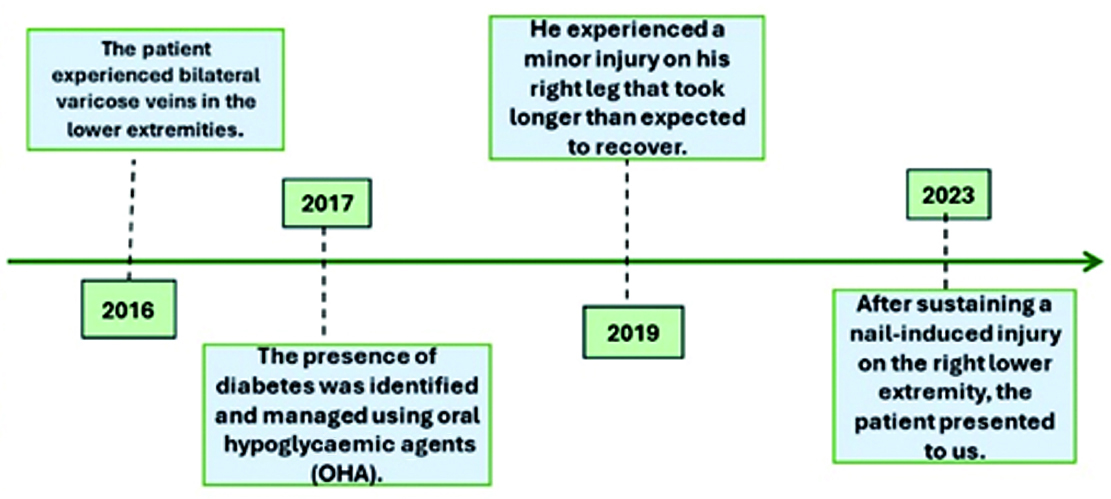
Initially, minor eruptions were observed in the ankle area near the inner ankle bone of his right leg. Within a week, these eruptions burst, resulting in a wound [Table/Fig-2]. The patient had a five-year history of diabetes mellitus and had previously been taking the oral hypoglycaemic drug metformin.
Wound at the first visit.
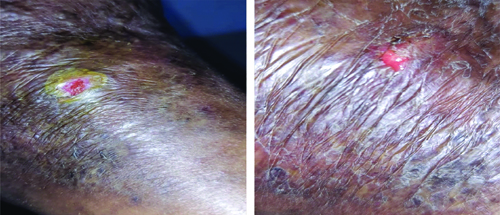
Additionally, varicosity was noted in both legs and the ankle region [Table/Fig-3].
Varicose vein in the right foot of the patient.
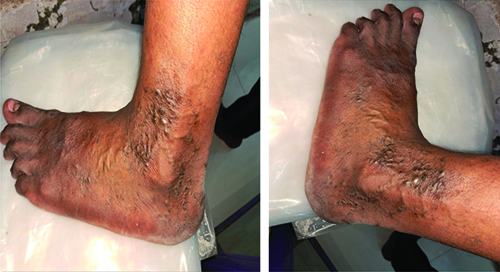
There were no previous records of smoking, alcohol use, narcotic use, or any other conditions such as hypothyroidism, hypocholesterolaemia, coagulation disorders, immunological disorders, allergies, or chemotherapy.
During the physical examination, a wound measuring 3 cm in length and 4 cm in height was observed. It had an almost circular shape with necrotic tissue and surrounding inflammation. The patient reported experiencing a moderate level of pain in this area, scoring it on a self-reported scale from 4 to 6, where ‘10’ represents the most severe pain and ‘0’ represents no pain. The physical examination revealed varicose veins in both legs. The pulse rate, blood pressure, heart rate, respiration rate, and temperature were within normal limits. His weight and height were recorded at 68 kg and 167.64 cm, respectively. Routine blood investigations were within the normal range. However, the levels of serum cholesterol and High Density Lipoprotein (HDL) cholesterol were found to be below the normal range. The physician recommended dietary changes, including a decrease in the consumption of trans fats and an increase in the intake of fresh vegetables. Fasting plasma glucose levels were measured at 334 mg/dL (reference range: 70-100 mg/dL). Additionally, the postprandial blood glucose level was recorded at 484 mg/dL (reference range: 90-140 mg/dL), and the glycosylated haemoglobin (HbA1c) level was measured at 12.6% (reference range: 4.6-6.2%). Therefore, the patient was diagnosed with diabetes and was experiencing inadequate management of blood glucose levels, indicating uncontrolled hyperglycaemia [Table/Fig-4].
| Test description | Observed value | Reference range |
|---|
| Serum cholesterol (mg/dL) | 128.0 | Desirable: <200Borderline high: 200-239High: >240 |
| Serum triglyceride (mg/dL) | 53.0 | Normal: <150Borderline high: 150-190High: 200-499Very High >500 |
| S.HDL cholesterol (mg/dL) | 35.5 | Desirable: <60Borderline: <40-60Low: <40 |
| LDL cholesterol (mg/dL) | 81.9 | Optimal: <100Near optimal: 100-129Borderline high: 130-159High: 160-189Very high: >190 |
| VLDL cholesterol (mg/dL) | 10.6 | 0-40 |
| CHOL/HDL Chol (Ratio) | 3.6 | 2 to 5 |
| LDL CHOL/HDL (Ratio) | 2.3 | 0 to 3.5 |
| Fasting plasma glucose (mg/dL) | 334.00 | 70-100 |
| Post prandial plasma glucose(mg/dL) (2 h after lunch) | 484.00 | 90-140 |
| Glycosylated haemoglobin (%) (HbA1c) | 12.6 | 4.6-6.2 |
This ailment was diagnosed as ‘Dushtavrana with Prameha’ from an Ayurvedic perspective. It was decided to continue the current oral hypoglycaemic medications as prescribed by the medical specialist while incorporating Ayurvedic medications through both oral and local applications as an adjunct treatment [Table/Fig-5].
| Modern medical treatment(oral administration) | Ayurvedic treatment | Duration |
|---|
| Local application | Oraladministration |
|---|
| Tab metformin 500 mg with an evening meal, every day. | 1. Cleaning of wound withPanchavalkala Kwatha followed by2. Application of YashtimadhuGhrita followed by3. Dressing of woundThe local application was done every 3rd day during the course. | Nishadhatri/Nishamalaki yoga or 5 gm twice a day with cold water, every day. | 25 days |
Treatment
1. Yashtimadhu Ghrita: One portion of Yashtimadhu powder was combined with 16 portions of water and heated until the volume was reduced to four portions. The prepared decoction was then filtered, and the resulting liquid was mixed with four portions of cow ghee. The mixture was heated until the water content evaporated [1].
2. Panchavalkala Kwatha: The bark of five different trees produces a medicine known as the Panchavalkala decoction. The trees are Vata (Ficusbengalensis Linn), Udumbara (Ficusglomerata Roxb.), Aśvattha (Ficusreligiosa Linn), Parisa (Thespesiapopulenoides L.), and Plaksha (FicuslacorBuch-Ham). This formulation possesses properties for cleansing (Shodhana) and healing (Ropan.a) wounds.
The pharmacy at the medical facility provided us with the unprocessed substances. Panchavalkala Kwatha was prepared by combining one part of Panchavalkala powder with eight parts of water. The mixture was cooked until only one-fourth of it remained. The substance was then filtered before use. This procedure was followed for each session with a freshly concocted Panchavalkala Kwatha [2].
3. The procedure for local application: The patient was informed about Ayurvedic treatments and provided written consent to undergo these procedures. All necessary aseptic measures were taken for local application. For the Panchakarma section, the consultant instructed the patient to remain on the table in a supine position. The consultant used freshly prepared Panchavalkala Kwatha, which was lukewarm (between 37°C and 39°C), to bathe the wound and the surrounding area. The consultant administered approximately 200 milliliters of Panchavalkala Kwatha all at once. Using sterile gauze, the consultant carefully removed pus, dead cells, and debris, cleaning the incision two to three times until it was clean. The consultant then applied Yashtimadhu Ghrita by placing sterile gauze soaked in lukewarm Yashtimadhu Ghrita into the wound [Table/Fig-6]. These procedures were performed every third day for a total of 25 days.
After procedure of local application.
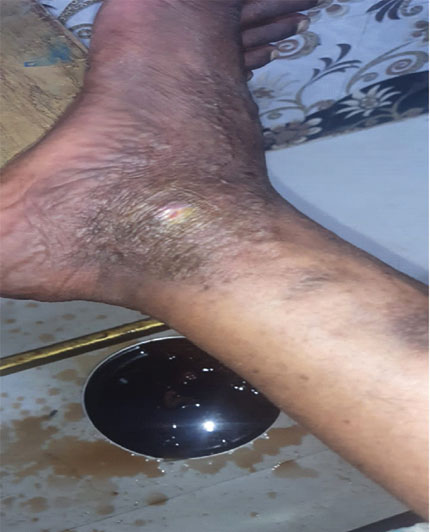
4. Nishadhatri/Nishamalaki Yoga: The physician recommended powdered Haridra (turmeric) and Amalaki (Indian gooseberry). The physician instructed the patient to soak both powders (2.5 grams each) in water overnight before consuming them on an empty stomach in the morning and in the evening with cold water for a duration of 25 days. The patient purchased these medications at the hospital’s on-site pharmacy [3].
Metformin: A modern medicine consultant prescribed a 500 mg metformin tablet, which the patient took once in the evening for a duration of 25 days.
Assessment: A comparison was made regarding the wound’s size, characteristics, pain level, and inflammation before, during, and after the therapy (25 days), and there was complete resolution of the symptoms post-treatment [Table/Fig-7].
Changes in the wound before/during, and after treatment.
(*a) Before treatmen; b,c) During treatment; d) After treatment)
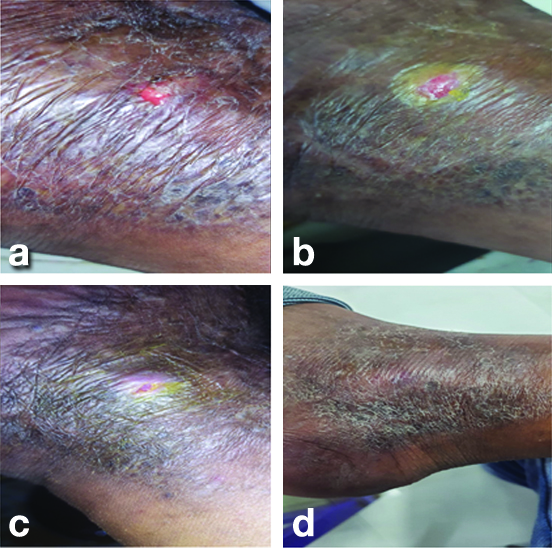
Discussion
This case report demonstrates the effectiveness of Panchavalkala kwatha Vranadhavan and Yashtimadhu Ghrita Vranaropana, along with oral Nishdhatri yoga as an adjunct to the oral hypoglycaemic drug metformin, in treating a diabetic wound. The patient had diabetes and a medical history of delayed wound healing, which necessitated vascular surgeon’s consultation. Additionally, varicose veins were present in both legs. These factors make this case distinctive and innovative. In this study, no adverse drug reactions were observed.
The incidence of diabetes in India is rising at a concerning pace. The World Health Organisation (WHO) anticipates a 37% increase in the worldwide population from 2000 to 2030. During the same period, the number of diabetes patients is projected to increase by 114% [4]. Diabetes plays a crucial role in causing delays in the healing process of wounds. Delayed wound healing in individuals with diabetes can be attributed to various factors, such as diminished nitric oxide synthesis, heightened glycation, and impaired migration of epithelial cells at the site of the lesion [5].
Ayurveda has been popular in India since ancient times, particularly for the management of non communicable ailments. The ‘Sushrut Samhita,’ an Ayurvedic text, contains detailed information on several Ayurvedic remedies and methods for the treatment of diabetic wounds. However, Ayurvedic consultants often share their findings through grey literature, which consists of non indexed journals, theses, or magazines written in local languages. The main factor contributing to the insufficient data supporting the effectiveness of Ayurveda in managing diabetic wounds is the lack of adequate evidence.
In a randomised controlled trial, a total of 23 patients with diabetic wounds were assigned to receive treatment with Katupila paste locally (Group A), while another 23 patients with diabetic wounds were treated with Betadine for a period of 30 days. The findings of the study indicated that the group treated with Katupila paste demonstrated better outcomes in the management of diabetic wounds [6].
Panchavalkala kwatha is derived from the bark of five distinct trees, one of which is the Vata, often known as the Indian banyan tree. The ethanolic extract of Ficus bengalensis bark produces a dose-dependent anti-inflammatory effect [7]. Vata, Udumbar, and Ashvatha contain tannins, phytosterols, and β-sitosterol-d-glucosides, which possess analgesic and anti-inflammatory properties. This combination produces vasoconstriction and resolves inflammation [8]. Traditional medicinal systems widely recognise Yastimadhu for its antioxidant, anti-inflammatory, antiviral, anticarcinogenic, and antiatherogenic properties. Recently, researchers discovered that the combination of liquorice extract and lavender essential oil has the potential to heal wounds [9].
Ayurveda provides abundant evidence regarding the efficacy of ghee in wound healing. Ghee and honey have been used to heal diabetic wounds. A study involving 29 individuals with non healing wounds indicated that the use of ghee and honey was effective in curing these wounds [10].
Conclusion(s)
This study emphasises the efficacy of Ayurvedic treatment, which consists of Panchavalkala Kwatha and Yashtimadhu Ghrita Vranadhavan, along with Nishamalaki yoga administered orally, as an adjuvant therapy for faster wound healing. It can also be utilised to prevent delayed wound healing in diabetic patients. However, due to the nature of being a single case study, the findings cannot be generalised. The key message from this case study is that the combination of Ayurvedic therapy with contemporary medications has the potential to effectively treat diabetic ulcers and prevent additional complications.
[1]. Rao MM, Hemant Kumar P, Panda P, Mukhi S, Bose A, Quality characterization of Madhuyashti ghrita International Journal of Ayurveda and Pharma Research 2020 8(7):21-27. [Google Scholar]
[2]. Meena RK, Dudhamal T, Gupta SK, Mahanta V, Wound healing potential of Pañcavalkala formulations in a postfistulectomy wound Anc Sci Life 2015 35(2):118-21. [Google Scholar]
[3]. Bedarkar PB, Ranpara N, Sawaliya V, Nariya MB, Prajapati PK, Patgiri B, Antihyperglycemic activity of nishamalaki-an ayurvedic European Journal of Biomedical and Pharmaceutical Sciences 2017 4(9):853-56. [Google Scholar]
[4]. Pandey A, Chawla S, Guchhait P, Type-2 diabetes: Current understanding and future perspectives IUBMB Life 2015 67(7):506-13. [Google Scholar]
[5]. Kulkarni SA, Deshpande SK, Rastogi A, Novel topical esmolol hydrochloride improves wound healing in diabetes by inhibiting aldose reductase, generation of advanced glycation end products, and facilitating the migration of fibroblasts Front Endocrinol (Lausanne) 2022 13:926129 [Google Scholar]
[6]. Ajmeer AS, Dudhamal TS, Gupta SK, Management of Madhumehajanya Vrana (diabetic wound) with Katupila (Securinega leucopyrus [Willd] Muell.) Kalka Ayu 2015 36(3):351-55.Available from: https://doi.org/10.4103/0974-8520.182744 [Google Scholar]
[7]. Patil VV, Pimprikar RB, Patil VR, Pharmacognostical studies and evaluation of anti-inflammatory activity of Ficus bengalensis linn Journal of Young Pharmacists 2013 1(1):49-53. [Google Scholar]
[8]. Bhat KS, Vishwesh BN, Sahu M, Shukla VK, A clinical study on the efficacy of Panchavalkala cream in Vrana Shodhana w.s.r to its action on microbial load and wound infection Ayu 2014 35(2):135-40. [Google Scholar]
[9]. Aly SH, Elissawy AM, Mahmoud AMA, El-Tokhy FS, Mageed SSA, Almahli H, Synergistic effect of Sophora japonica and Glycyrrhiza glabra flavonoid-rich fractions on wound healing: In vivo and molecular docking studies Molecules 2023 28(7):2994 [Google Scholar]
[10]. Udwadia TE, Ghee and honey dressing for infected wounds Indian J Surg 2011 73(4):278-83. [Google Scholar]